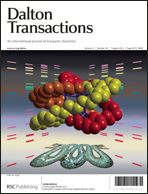Luminescence mechanochromism in cyclometallated Ir(iii) complexes containing picolylamine†
Abstract
The synthesis, crystal structure and luminescence properties of three cyclometalated Ir(III) complexes of general formula [(ppy)2Ir(pam)]X, where X = Cl− (1), PF6− (2), ClO4−(3), and pam = 2-picolylamine, are described. While 2 and 3 crystallize in a unique form, two pseudo-polymorphs, a solvated (1a) and a non-solvated (1b) species, have been observed for compound 1. 1a crystallizes in the monoclinic centrosymmetric space group P2(1)/c. On the contrary, 1b, 2 and 3 crystallize in the non-centrosymmetric space group P2(1)2(1)2(1) (1b) and Pca2(1) (2 and 3), respectively. All the crystalline supramolecular materials have been fully photophysically characterized. While 1 shows a bright blue–green emission in both solution and solvated crystalline state 1a, crystals of 1b, 2 and 3 show a significantly red shifted emission with respect to solution. Unexpectedly, and differently from 1a, mechanical stimuli-responsive colour and luminescence changes have been observed for 1b, 2 and 3. Upon mechanical grinding the colour of the crystalline solids changes from orange to yellow while the emission energy is partially (2 and 3) or completely (1b) converted from orange to green. The grinding-triggered colour and luminescence changes have been attributed to a crystal-to-amorphous phase conversion for all crystalline solids.


 Please wait while we load your content...
Please wait while we load your content...